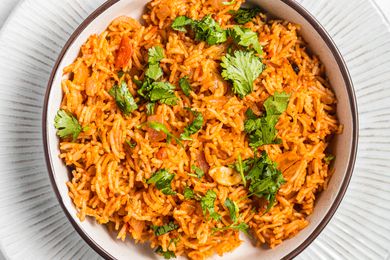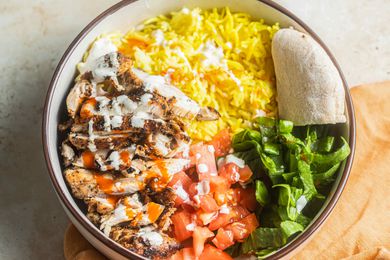:max_bytes(150000):strip_icc()/Simply-Recipes-Garam-Masala-LEAD-2-V-5-4cb3a1111af64447bdbf7c470bc6b504.jpg)
Simply Recipes / Karishma Pradhan
There is nothing like the smell of earthy, sweet, and freshly toasted spices in the kitchen. As a child, this was a familiar scent I came to expect on weekend mornings when my mother was grinding whole spices into fragrant powders to store in the pantry.
Fresh spice blends, such as the popular garam masala, add delicious aroma and flavor to South Asian dals, curries, and stir-fries.
What Is Garam Masala?
Garam masala is a ubiquitous spice blend popular in South Asia and the Caribbean. It often contains a combination of sweet, earthy spices. Garam translates to "hot," referring to the spices' hypothesized warming effect on the body in Ayurvedic medicine, as opposed to tasting "spicy."
What Spices Are in Garam Masala?
Garam masala doesn't have a specific set of ingredients or ratio of ingredients. In fact, each spice blend varies significantly from household to household.
For example, the version I grew up with was a Maharashtrian variation of garam masala called goda masala, which yields a subtly sweet flavor and contains many additional ingredients, like coconut, chilies, and sesame seeds. Even still, my aunt makes her own secret batch with her own perfect ratio of ingredients.
That said, the most popular ingredients are cinnamon, cardamom, black pepper, cloves, and often coriander and cumin. In addition, some versions include mace, nutmeg, fennel seeds, and rose petals.
:max_bytes(150000):strip_icc()/Simply-Recipes-Garam-Masala-LEAD-1-H-2-24d440f995bc419cb5f2d8f455561578.jpg)
Simply Recipes / Karishma Pradhan
Why Make Homemade Garam Masala?
Homemade garam masala offers two main advantages over store-bought powders:
- Toasting and grinding whole spices into a powder yields an incredibly fresh and aromatic spice blend compared to a store-bought mix.
- If you make it yourself, you can adapt it to your taste preference. Want a spicier version? Add more black peppercorns. Love fennel seeds? Feel free to add some to your mix!
How to Use It
You can use garam masala in many different ways. I love adding it to a marinade for chicken or fish, mixing it into a curry paste, or blending it with yogurt as a dipping sauce.
If you're making a dal, curry, or soup, add the garam masala during the simmering step toward the end of cooking.
Tips and Tricks
To keep things simple, efficient, and flavorful, keep in mind a few tips:
- Low and slow is the way to go. When toasting your spices, keep the heat on medium-low and stir frequently. Once spices burn, they taste bitter and inedible, so the slower you go, the better!
- Avoid inhaling freshly ground spices. Freshly ground spices are deliciously fragrant, but they're also potent! Avoid inhaling near the spices to prevent yourself from sneezing or coughing.
- Keep a "mix" of whole spices for easy access. I'll often make a big batch of the raw, untoasted spices, mix them well, then keep them in the pantry in an airtight container. When I want to grind a batch of garam masala, I'll scoop as much as I want, then toast and grind them up.
:max_bytes(150000):strip_icc()/Simply-Recipes-Garam-Masala-LEAD-2-V-3-2ae9adccaa8d4d73a51829dcae589873.jpg)
Simply Recipes / Karishma Pradhan
Swaps and Substitutions
Most of the spices can be found in an everyday supermarket. If you’re having trouble sourcing the spices, I recommend shopping at your local specialty spice shop or shopping online at Diaspora Co., Curio Spice, or Amazon.
Here are some easy pantry swaps:
- Swap out 1/2 teaspoon of the green cardamom pods for black cardamom seeds for a slightly smokier flavor.
- If you can’t find Ceylon cinnamon (sometimes called “true cinnamon”), use 1/4 stick of Cassia cinnamon bark, which is more commonly found in stores in the US.
- If you can’t find Tej Patta, use 1 dried laurel bay leaf.
- Add 1/4 teaspoon ground nutmeg to the freshly ground spices for additional flavor.
Recipes to Make With Your Garam Masala
Garam Masala
Most of the spices can be found in an everyday supermarket. If you’re having trouble sourcing the spices, I recommend shopping at your local specialty spice shop or shopping online at Diaspora Co., Curio Spice, or Amazon. For variations and pantry swaps, see the article above.
Ingredients
-
2 tablespoons plus 1 teaspoon (15g) coriander seeds
-
4 teaspoons (10g) cumin seeds
-
2 teaspoons (6g) green cardamom pods
-
3/4 teaspoon whole cloves (1g)
-
1 teaspoon black peppercorns (3g)
-
1/2 stick (2.9g) Ceylon cinnamon
-
1/2 (0.3g) Tej patta (Indian bay leaf), crushed into 1/2-inch pieces (optional)
Method
-
Toast the spices:
If using an electric burner, set a medium skillet over medium-low heat until warm to the touch. Add coriander, cumin, cardamom, cloves, peppercorns, cinnamon, and bay leaf pieces to the skillet.
If using a gas burner, add the spices directly to a medium skillet, then set the skillet over medium-low heat.
Stir frequently with a wooden spoon until the spices are aromatic and lightly toasted, about 2 to 3 minutes (I often find my spices are nicely toasted about 30 seconds to 1 minute after I begin smelling their aromas). Immediately transfer the spices to a plate to halt the cooking process and allow them to cool completely.
Simple Tip!
Sometimes, it can be tricky to determine if the spices are properly toasted. Here's a trick: Take a raw cardamom pod and a raw cumin seed and compare the colors to the cardamom and cumin in your skillet; if they appear darker in the skillet, the spices are done. When in doubt, remove the spices from the heat to prevent them from burning (you can always put them back over the heat if they're not quite done).
![Whole Spices in a Cast Iron Skillet]()
Simply Recipes / Karishma Pradhan
-
Grind the spices:
Once cooled, transfer the spices to a spice grinder, coffee grinder, or food processor. Grind until the mixture resembles a fine powder.
Simple Tip!
You can also grind the spices in a mortar and pestle (though it will take a bit longer).
![Toasted Spices in a Spice Grinder]()
Simply Recipes / Karishma Pradhan
![Garam Masala Powder in the Spice Grinder]()
Simply Recipes / Karishma Pradhan
-
Jar the spices and store:
Transfer the freshly ground spices to a small, airtight jar and seal completely. I like to label my jar 'Garam Masala' with the current date, so I know how fresh it is!
Homemade garam masala will last up to 6 months in an airtight container stored in a cool, dark spot; however, it's freshest within the first few weeks.
Love the recipe? Leave us stars and a comment below!
| Nutrition Facts (per serving) | |
|---|---|
| 2 | Calories |
| 0g | Fat |
| 0g | Carbs |
| 0g | Protein |
| Nutrition Facts | |
|---|---|
| Servings: 48 | |
| Amount per serving | |
| Calories | 2 |
| % Daily Value* | |
| Total Fat 0g | 0% |
| Saturated Fat 0g | 0% |
| Cholesterol 0mg | 0% |
| Sodium 1mg | 0% |
| Total Carbohydrate 0g | 0% |
| Dietary Fiber 0g | 1% |
| Total Sugars 0g | |
| Protein 0g | |
| Vitamin C 0mg | 1% |
| Calcium 6mg | 0% |
| Iron 0mg | 1% |
| Potassium 10mg | 0% |
| *The % Daily Value (DV) tells you how much a nutrient in a food serving contributes to a daily diet. 2,000 calories a day is used for general nutrition advice. | |
:max_bytes(150000):strip_icc()/Simply-Recipes-Garam-Masala-METHOD-1-e064482a572744de9819d68a18682754.jpg)
:max_bytes(150000):strip_icc()/Simply-Recipes-Garam-Masala-METHOD-2-9d1da742873041b98bfee00d4b2b0abf.jpg)
:max_bytes(150000):strip_icc()/Simply-Recipes-Garam-Masala-METHOD-3-e438ad9e9dd44a948e25794f468083e8.jpg)

